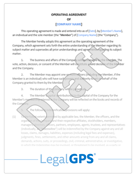Why Your Business Needs a Shareholder Agreement: Key Insights and Benefits
When starting a corporation with others, it’s easy to focus on the opportunities and overlook the risks. Beyond competition and product viability,...
4 min read
LegalGPS : Oct. 9, 2024
A shareholder agreement is crucial for aligning the interests of shareholders, managing potential conflicts, and setting clear expectations for how your company will be run. Drafting one is about more than just filling out a template—it requires careful thought to cover what’s best for your corporation and shareholders. Let’s break down what you need to include and why it matters.


Legal GPS Pro
Protect your business with our complete legal subscription service, designed by top startup attorneys.
A shareholder agreement is a legal document that outlines the rights and responsibilities of a company’s shareholders. Unlike those detailed in our step-by-step guide to corporate bylaws, shareholder agreements address relationships between shareholders. A shareholder agreement deals specifically with the relationships between shareholders and how decisions affecting the company will be made. Key provisions to include in your agreement cover management control, voting rights, buying and selling of shares, and much more.
The beauty of a shareholder agreement is its flexibility—there’s no one-size-fits-all template. Instead, you include what your company needs to operate smoothly and fairly.
Drafting a shareholder agreement might seem overwhelming, but focusing on the essentials will help you get started.
In most corporations, the board of directors makes major decisions. However, you can give shareholders more control through your shareholder agreement.
Shareholder Voting Rights: You can list out the decisions that require shareholder approval before the board can act. For example, you might require a shareholder vote for issuing new shares, approving bank loans, or entering specific contracts.
Voting Percentages: Different decisions might need different levels of approval. For bigger decisions, you could require a supermajority (e.g., 66% of shareholders) instead of a simple majority. This provides more protection for minority shareholders.
Tip: Don’t give minority shareholders too much power. A minority shareholder with veto rights could hold your company hostage, making it difficult to make necessary business moves.
A shareholder agreement should address how directors are nominated, elected, and removed.
Nomination of Directors: Investors may want representation on the board. Your agreement should outline who gets to appoint which directors. For example, you might allow a major investor to nominate one director, while the rest are chosen by other shareholders.
Removal of Directors: Specify when and how directors can be removed. You could set particular conditions or allow removal without cause. Be careful, though—allowing directors to be removed without cause might leave minority shareholders at a disadvantage if they can’t protect their interests.
Tip: Align removal rules with protections for minority shareholders to prevent any imbalance of power.
Life happens, and shareholders might need or want to exit the company. Establishing clear rules for buying and selling shares will help you avoid future conflicts.
Permitted Transfers: Decide if shareholders can transfer shares freely or if restrictions apply. You might allow transfers only to close family members or require the new shareholder to be involved in the business.
Right to Repurchase: If a shareholder dies or becomes unable to participate, you may want to buy back their shares. Define how this works, including any terms (e.g., a promissory note) that might be used to fund the purchase.
Example: If a co-founder passes away and their family inherits their shares, you might want to repurchase the shares to keep control within active management. A promissory note could allow you to do this over time without needing large upfront cash.


Legal GPS Pro
Protect your business with our complete legal subscription service, designed by top startup attorneys.
Preemptive rights allow existing shareholders to maintain their ownership percentage if new shares are issued.
Maintain Ownership: If your company issues new shares, preemptive rights give shareholders the chance to buy additional shares to maintain their ownership stake.
Investor Considerations: Investors often request preemptive rights as a safeguard against dilution of their ownership.
Example: If your startup issues 100,000 new shares, a shareholder with 10,000 shares would have the right to buy 10,000 of the new shares to maintain their 10% stake.
These provisions are helpful if a shareholder wants to sell their shares.
Right of First Offer: The shareholder must first offer their shares to the existing shareholders before seeking a third-party buyer. This keeps shares within the current ownership group.
Right of First Refusal: If a shareholder receives an offer from a third party, they must give the existing shareholders the opportunity to buy those shares under the same terms.
Tip: These provisions ensure control over who becomes a shareholder, preventing unwanted parties from acquiring an interest in your company.
Tag-along and drag-along rights are crucial for balancing the interests of majority and minority shareholders.
Tag-Along Rights: If a majority shareholder decides to sell their shares, tag-along rights allow minority shareholders to join the sale under the same terms. This ensures they aren’t left behind.
Drag-Along Rights: Conversely, drag-along rights allow a majority shareholder to force minority shareholders to sell their shares if a suitable offer is received. This prevents minority shareholders from blocking a deal that benefits the majority.
Example: If you own 70% of the company and receive an offer to sell, drag-along rights allow you to require the minority shareholders to sell their shares as well. This can help ensure a smooth transaction.
Overcomplicating Voting Rights: While giving shareholders a voice is important, making voting rules too complex can hinder decision-making. Strike a balance that protects shareholders but allows for efficient operations.
Ignoring Exit Strategies: Failing to include clear buy-sell provisions can lead to disputes when a shareholder wants out. Address these early to avoid headaches later.
Lack of Minority Protection: Ensure there are enough safeguards for minority shareholders without giving them excessive power that can obstruct operations.
A shareholder agreement isn’t just paperwork—it’s a key document that helps define how your corporation is managed, protects shareholder interests, and helps prevent conflicts before they arise. Drafting a comprehensive agreement takes time and careful thought, but it’s well worth the effort.
The biggest question now is, "Do I need a lawyer to start a business?” For most businesses and in most cases, you don't need a lawyer to start your business. Instead, many business owners rely on Legal GPS Pro to help with legal issues.
Legal GPS Pro is your All-In-One Legal Toolkit for Businesses. Developed by top startup attorneys, Pro gives you access to 100+ expertly crafted templates including operating agreements, NDAs, and service agreements, and an interactive platform. All designed to protect your company and set it up for lasting success.

Legal GPS Pro
Protect your business with our complete legal subscription service, designed by top startup attorneys.

100+ legal templates, guides, and expert advice to protect your business.
Trusted by 1000+ businesses

When starting a corporation with others, it’s easy to focus on the opportunities and overlook the risks. Beyond competition and product viability,...

Deciding where to incorporate your business is a crucial step that can significantly impact your company's legal protections, tax obligations, and...

Corporate bylaws are the backbone of your business—they define how your corporation operates, make roles and responsibilities clear, and ensure...